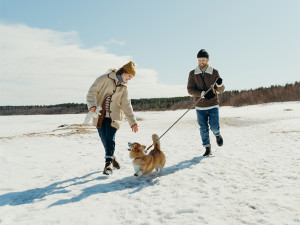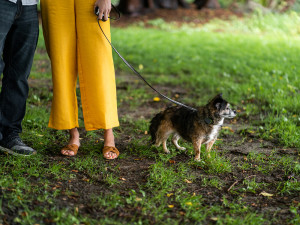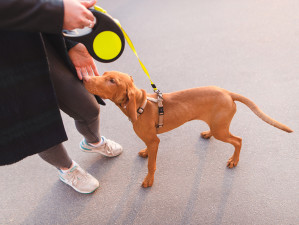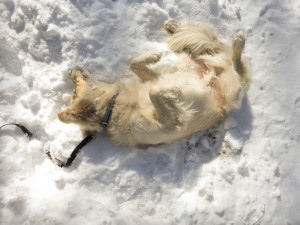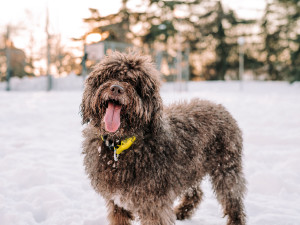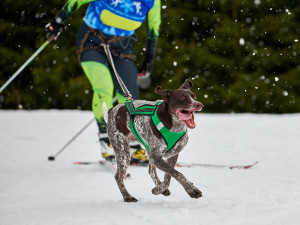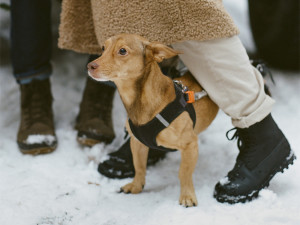How to Teach Your Dog to Poop in the Snow
Snow days are fun—until your pup needs to do their thing outside.
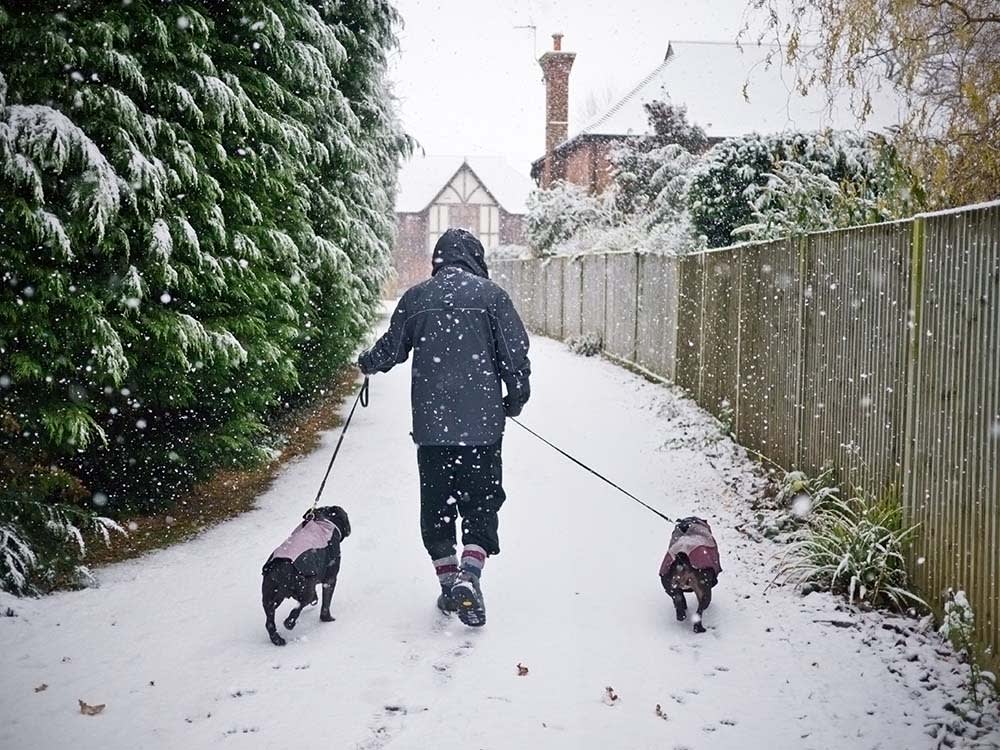
share article
In this Article:
Why Do Dogs Hate Pooping in the Snow?opens in a new tab Tips to Help Dogs Poop in Snowopens in a new tab How to Train Your Dog to Poop in the Snowopens in a new tab How Cold is Too Cold for My Dog To Poop Outside?opens in a new tab
The world is divided into people whose dogs absolutely love everything about snow and people whose dogs don’t want to poop in snow, thus making winter a horribly stressful and annoying season. The problem has been magnified lately because we’re in another winter of wild weather. Far too many of us are facing giant snowstorms, huge drifts, and extreme cold.
The shoveling, road conditions, and heating bills are bad enough, but this no-that’s-not-the-bathroom-anymore attitude of dogs across the nation and beyond is making snow Enemy Number One. If you have found yourself in the yard saying with despair, “Oh for the love of god will you please just come out and poop?” you may want to come inside, yank off your boots, and read a bit about how to make this snowy winter easier on you and your dog.
Why do dogs hate pooping in the snow?
If your dog refuses to poop in snow (or pee), it’s natural to feel frustrated and annoyed. You’re frustrated because you are spending a lot of time outside trying to get your dog to poop when you could be inside with hot cocoa, happily enjoying the winter wonderland from the coziness of your favorite chair. You’re annoyed because cleaning up poop and pee when your dog has been properly housetrained for years is annoying (and maddening and gross, and unfair, and, well you get the idea.)
Everybody has a perfect right to feel how they feel, but I must put in a word for our dogs here and suggest that another worthwhile way to feel is sympathetic. When a dog doesn’t want to poop in the snow, it’s not because they are being difficult. This situation is a classic example of a dog who is having a hard time rather than a dog who is giving you a hard time. They are most likely confused or uncomfortable, and they need our help.
Puppies are used to whatever surface they were trained on — grass, leaves, concrete, or pee pads — and will likely prefer that for the rest of their life. When dogs encounter snow for the first time, they often just don’t know that it is OK to pee or poop on it. So, while raising a puppy in the dead of winter has its challenges (read: miseries), those who learn their housetraining skills at this time are less likely to balk at the snow each season. Clearly a lot of dogs make sense of snow either right away or eventually. Otherwise, yellow snow would not be a thing.
Sensory discomfort in the snow
The issue of discomfort is a little more obvious — it’s cold! There’s the cold winter air itself and the cold snow which doesn’t feel good on their paws (or on their legs or bellies or…well, anywhere). If your dog is unfamiliar with snow, it’s not a fun feeling. Dogs who get cold easily (the ones who shiver when it drops below 70 are just like me!) aren’t always fans of the cold under any circumstances, but can barely keep their heads above all the fluffy white stuff after a blizzard. It’s understandable that they would be particularly resistant to head out at all — and unable to relax enough to do their business once they do.
And if their fur traps snowballs on their feet, legs, and belly, they have every reason to object when we expect them to endure that. Individual dogs vary in their ability to handle cold, but generally speaking, small and slender ones with short fur suffer the most.
Tips to help your dog poop in the snow
Sometimes it’s the little things — just a few tweaks and your dog is back to business (literally). In other cases, a touch more effort may be needed, but all these tips have been successful for many people and their dogs.
1. Make your yard more welcoming.
One method is to shovel a pathway from the door to the potty area — a patch of grass or, better yet, a spot protected from the snow, such as under a balcony. Most dogs are more likely to do their business if a snow-free zone is easily accessible to them so that they can quickly rush back indoors.
Also, if the area smells more like what they are used to, it is easier for them to poop like they usually do. Keep up with the poop pickup — daily poop pick-up is more important than ever during this season. Using kitty litter on the ground can provide pups with better traction when things get slippery. If all else fails, hire a professional pooper-scooper company.
2. Be a storm trooper, and join your dog outside in the snow.
Some dogs have shy bladders, but others will appreciate a show of solidarity. You may not want to accompany your dog out in freezing temperatures, but you may also find that it leads to success. It could take several outings, though — if five to 10 minutes have gone by and your dog still hasn’t gone, bring them back inside, but on a leash so they can’t sneak off behind your back.
Though this method takes considerable effort, it does work for most dogs. Some dogs struggle when their yard is blanketed with snow but are more inspired to go to the bathroom on walks through the neighborhood. Leading your dog to areas where other dogs have already gone (seek out that yellow snow) may encourage your dog, too.
3. Dress your dog for success (in warm clothes).
Dressing for success is not just a business idea. It applies to everything in life, it includes our dogs, and it can be the difference maker when it comes to convincing them to potty outside, just as they do in the summer. Sometimes the reason a dog won’t potty when it’s cold is not about the snow at all. Some dogs won’t poop in cold weather, even if the ground is dry. They are happy to remain where it’s warm and stay occupied insideopens in a new tab, thank you very much, and the result is a dog who poops inside when the weather is cold.
Canine coatsopens in a new tab are functional, as well as fashionable. Putting socks, booties, or boots on your dog’s feet can be the difference-maker in some cases. Dressing your dog for winter weather can make them more comfortable and more willing to head outside. Warm-weather clothing may make them willing to stay outside long enough to take care of business. I myself never go outside in the most foul of winter weather (not even to the mailbox!) without properly suiting up.
4. It’s a poop tent, not a pup tent
A snow poop tent for the dog can make everybody’s life easier. If you didn’t know you needed a dog snow poop tent, well, now you do! It’s exactly what it sounds like — a tent that protects the ground from the snow so there is still a grass or dirt area that your dog can use as the bathroom during winter.
Using a sports pop-up tent can work, especially if you use plywood to make sides that keep snow from blowing in. You can use an old camping tent with the floor removed, or build your own out of whatever materials you want. As long as the area is protected from snow, and there is no floor to it so your dog can smell the great outdoors, a dog snow poop tent may be the solution you need. Some dogs walk to the poop tent to go, and others get carried — whatever works!
5. Hay, straw, or a carpet — comfort leads to pooping.
For dogs who don’t want to walk on snow or are otherwise uncomfortable using the yard in the winter, try changing the surface for them. Putting down hay or straw is enough to help some dogs overcome their anti-poop protest.
Other dogs do well if you put out an old carpet remnant on top of the snow. Anything to make it more comfortable for the season is worth trying! The straw can be left in the yard, but the carpet remnant is something I would pitch once springtime comes. It’s hard to clean it after a season of being out in the elements and being pooped on.
Training your dog to poop in the snow
If you want to know how to get dogs to poop (and pee!) in the snow, don’t forget the obvious. Training your dog makes the behavior you want more likely to happen, so training your dog to poop and pee in the snow is an important piece of the puzzle. But training will be so much more effective if you start early, long before you look outside and see a winter wonderland that you didn’t ask for and you know your dog could do without.
When it snows, go back to a housetraining 101 approach. Take your dog out when there is just the smallest hint of snow (I know, it’s hard to coordinate with Jack Frost, but do your best) and encourage them to poop. You can encourage a dog to poop by taking them to a spot they usually like to use, give them the cue you taught them, and wait. Patience is important.
When they do go, give them opens in a new tab, and be generous with them. Every chance you get to have them be in light snow is an opportunity to teach them that the snow is not covering the bathroom; the snow is the bathroom. Take them into the yard and on walks to pee and poop — flexibility about bathrooms is the goal! As the snow accumulates, you may need to clear a path or shovel out an area for their business, depending on their size and their changing attitude toward pooping in the snow.
How cold is too cold for my dog to poop outside?
We all want our dogs to be safe in the snow and coldopens in a new tab. There are temperatures too low for dogs to be outside safely, but those vary for every dog. The average Husky will be able to handle winter weather without risking frostbite, unlike the average Basenji, but it’s wise to ask your vet about limitations for your particular dog. And temperatures that are too low for an all-day adventure or even a 45-minute walk may not be too cold for a quick visit outside to pee and poop.
The temperature at which your dog cries foul about having an outside bathroom, however, is entirely up to them. They have the final say on when it is too cold for a dog to poop outside without your help. It doesn’t matter what other experts might say. In this case, your dog has the only expert opinion on the subject that really matters. They know when it is too cold for a dog to poop outside, and you can figure it out because they may refuse to go into the yard at all, or you may find you have a dog pooping in the house in cold weather.
FAQs (People also ask):
What is the best way to clean up dog poop in the snow?
It’s better to scoop poop right away before it freezes in the snow and becomes a gross spring thaw situation. The best way to pick up dog poop in snow is the same as in warmer seasons — with a plastic poop bagopens in a new tab or a shovel.
Why do dogs cover their poop with snow?
Theories about why dogs cover their poop with snow include concealing their scent from rivals. Another possibility is they are pawing at the ground to mark the spot with glands in their paws rather than actually trying to bury their poop.
Are specific breeds less likely to want to poop in the snow?
Dogs who are sensitive to cold are less likely to want to poop in the snow. Dogs who are small, have short legs, are slender, or who have short fur are generally more common in the anti-snow poopers group.

Karen B. London, PhD, CAAB, CPDT-KA
Karen B. London, Ph.D., is a Certified Applied Animal Behaviorist and Certified Professional Dog Trainer who specializes in working with dogs with serious behavioral issues, including aggression, and has also trained other animals including cats, birds, snakes, and insects. She writes the animal column for the Arizona Daily Sun and is an Adjunct Professor in the Department of Biological Sciences at Northern Arizona University. She is the author of six books about training and behavior, including her most recent, Treat Everyone Like a Dog: How a Dog Trainer’s World View Can Improve Your Lifeopens in a new tab.
Related articles
![Winterizing your dog's coat - Dog laying in the snow.]() opens in a new tab
opens in a new tabNatural Remedies for Dry Skin: How to Help Dry Skin on Dogs
Spoiler: These at-home remedies are probably already in your pantry.
![shaggy brown dog plays in the snow outside]() opens in a new tab
opens in a new tabHow to Keep You and Your Dog Out of the Snow
Tips to avoid boredom when cooped up during all this winter weather.
![Skijoring brown dog in snow sport racing with owner]() opens in a new tab
opens in a new tabHow to Ski With Your Dog
Dogs don’t have to be pro athletes to enjoy some quality time in the snow.
![Pit Bull dog wearing a coat on leash with person in the snow]() opens in a new tab
opens in a new tabDoes Your Dog Need a Winter Coat?
Chilly pup refusing to layer? Here’s how to train them to love their winter wardrobe.
![A couple bundled up for winter standing outside in the snow with their dog.]() opens in a new tab
opens in a new tabCan Dogs Get Frostbite?
Yep, all those warnings your mom gave you as a kid apply to your dog, too. Learn how to keep your pup safe in the cold.
